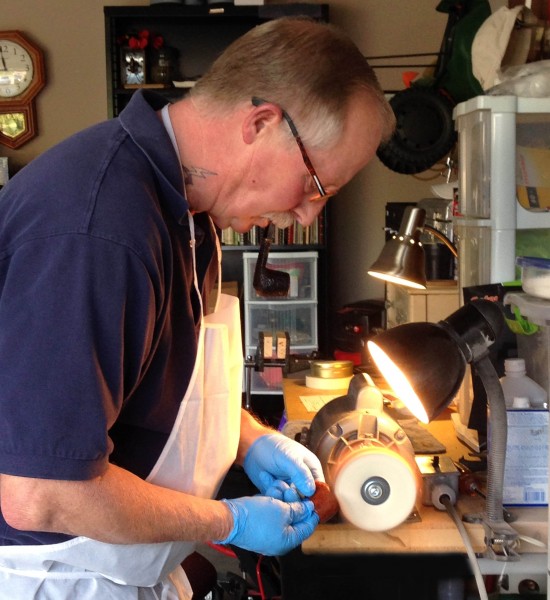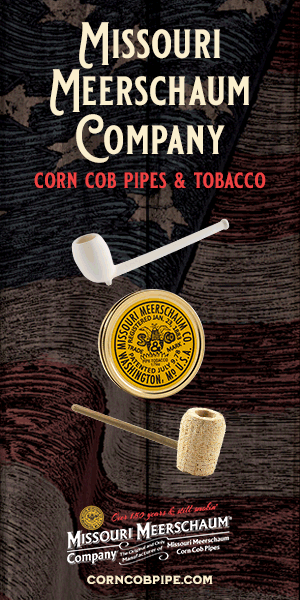How to wax to get the shine?
- Thread starter moonman
- Start date
You are using an out of date browser. It may not display this or other websites correctly.
You should upgrade or use an alternative browser.
You should upgrade or use an alternative browser.
SmokingPipes.com Updates
Watch for Updates Twice a Week
- Status
- Not open for further replies.
Cortez, you are so right! I do that final sanding with 2400 grit before polishing.High gloss, absolutely glassy shines depend on very finely sanded wood.
Lots of good info here....I have been doing my final sanding with 2000 grit...I will up to a high grit. Had really goods results with the last Peterson I restored.
fnord...I use a 1/3hp, 1725rpm motor that turns counter-clockwise with the Beall 4" buffer system...came with all three compounds and polishes. Came to $49 for all of, pretty nice system.
http://www.bealltool.com/products/buffing/buffer.php

fnord...I use a 1/3hp, 1725rpm motor that turns counter-clockwise with the Beall 4" buffer system...came with all three compounds and polishes. Came to $49 for all of, pretty nice system.
http://www.bealltool.com/products/buffing/buffer.php

I suggest stepping up the fine grain sandpaper. Wet sand the hell out of it until the wood shines without wax. When you achieve a shine on the naked briar, putting a buffing wheel on it will make it look like glass.
As others have noted, this pipe may have had some kind of oil rubbed into it thus preventing a high shine. But here is what I do to achieve a high shine.
I don’t sand any pipes, but on estate pipes I do ensure the bowl surface is clean using a little rubbing alcohol and a rag or a soft bristle toothbrush for non-smooth bowls. From time to time, I do this on other pipes I feel may need it.
Once clean:
Load the buffing wheel with carnauba – buff with firm pressure.
Wipe with clean flannel or cotton rag
Reload #60 wheel with carnauba then buff entire pipe with medium to gradually lighter pressure
Wipe with clean flannel or cotton rag
Reload #60 wheel with carnauba then buff pipe with a “baby’s breath” touch. This last step is the ‘secret’ for a brilliant finish as a few other members have noted.
Finally, buff with a virgin wheel (no carnauba), again with a ‘baby’s breath’ touch.
A little info on buffing speeds.
I don’t have a buffing machine. I use a 4 step bench drill press which is a wee more versatile than a buffer, i.e., you can actually drill holes with it. :D The only difference is that the wheel on the former runs vertically and the wheel on the latter runs horizontally – not a problem. Used drill presses may be available for sale on Craigslist or on eBay for PICK UP only.
I set the belt on my drill press to run at a spindle rate of 1100 RPM, slower than the 1725 RPM used by most folks for buffing pipes. I like 1100 RPM as I have more control of the pipe, i.e., it is less likely to fly out of my hand. 1100 RPM is also the speed recommended by Mark Tinsky when I asked him. Regardless of the speed, always place a waste basket or box filled with any kind of cushioning material such as old towels, sheets, blankets, etc. on the ‘exhaust side’ of the buffing wheel. You will regret not doing this when a pipe goes flying across the room or to the (concrete?) floor with the end result being a broken stem and a small piece of firewood, or at the very least, surface damage to the pipe. I place a Workmate workbench to the left of my drill press, some two by fours, and prop a wastebasket filled with old towels to catch any pipe that may slip out of my hands. Believe me, this cushioned wastebasket has saved many a good pipe…and bad ones too.
Calculating Buffing Speeds
There are two things to keep in mind when buffing: S.F.P.M. and the spindle/arbor speed/rate of your buffer.
S.F.P.M.,or the SURFACE SPEED, is the speed at which the face (outside edge) of your buffing wheel travels as distinguished from the SPINDLE/ARBOR SPEED of your buffer or drill press, or whatever it might be. For best results, the S.F.P.M. should be somewhere between 1100 SFPM and 1725 SFPM.
The SFPM can be calculated using the following formula and the SFPM will vary based on the diameter of the buffing wheels being used. Using this formula, you can see that only a 4” buffing wheel will have the same SFPM and Spindle/Arbor RPM. For all other sizes of buffing wheels, the two figures will vary. Most people use the 6” or 8” wheels because, if you are the least bit careless, the smaller 4” wheels can place your pipe in harm’s way where it could be nicked or damaged by the metal arbor.
Formula to calculate SFPM
SFPM = ¼ the diameter of the buffing wheel x the SPINDLE/ARBOR RPM.
Thus, for a 6” buffing wheel having a SPINDLE /ARBOR SPEED of 1100 RPM, the SFPM would be 1650. (1.5 x 1100 = 1650). This SFPM is well within the range for buffing pipes.
I don’t sand any pipes, but on estate pipes I do ensure the bowl surface is clean using a little rubbing alcohol and a rag or a soft bristle toothbrush for non-smooth bowls. From time to time, I do this on other pipes I feel may need it.
Once clean:
Load the buffing wheel with carnauba – buff with firm pressure.
Wipe with clean flannel or cotton rag
Reload #60 wheel with carnauba then buff entire pipe with medium to gradually lighter pressure
Wipe with clean flannel or cotton rag
Reload #60 wheel with carnauba then buff pipe with a “baby’s breath” touch. This last step is the ‘secret’ for a brilliant finish as a few other members have noted.
Finally, buff with a virgin wheel (no carnauba), again with a ‘baby’s breath’ touch.
A little info on buffing speeds.
I don’t have a buffing machine. I use a 4 step bench drill press which is a wee more versatile than a buffer, i.e., you can actually drill holes with it. :D The only difference is that the wheel on the former runs vertically and the wheel on the latter runs horizontally – not a problem. Used drill presses may be available for sale on Craigslist or on eBay for PICK UP only.
I set the belt on my drill press to run at a spindle rate of 1100 RPM, slower than the 1725 RPM used by most folks for buffing pipes. I like 1100 RPM as I have more control of the pipe, i.e., it is less likely to fly out of my hand. 1100 RPM is also the speed recommended by Mark Tinsky when I asked him. Regardless of the speed, always place a waste basket or box filled with any kind of cushioning material such as old towels, sheets, blankets, etc. on the ‘exhaust side’ of the buffing wheel. You will regret not doing this when a pipe goes flying across the room or to the (concrete?) floor with the end result being a broken stem and a small piece of firewood, or at the very least, surface damage to the pipe. I place a Workmate workbench to the left of my drill press, some two by fours, and prop a wastebasket filled with old towels to catch any pipe that may slip out of my hands. Believe me, this cushioned wastebasket has saved many a good pipe…and bad ones too.
Calculating Buffing Speeds
There are two things to keep in mind when buffing: S.F.P.M. and the spindle/arbor speed/rate of your buffer.
S.F.P.M.,or the SURFACE SPEED, is the speed at which the face (outside edge) of your buffing wheel travels as distinguished from the SPINDLE/ARBOR SPEED of your buffer or drill press, or whatever it might be. For best results, the S.F.P.M. should be somewhere between 1100 SFPM and 1725 SFPM.
The SFPM can be calculated using the following formula and the SFPM will vary based on the diameter of the buffing wheels being used. Using this formula, you can see that only a 4” buffing wheel will have the same SFPM and Spindle/Arbor RPM. For all other sizes of buffing wheels, the two figures will vary. Most people use the 6” or 8” wheels because, if you are the least bit careless, the smaller 4” wheels can place your pipe in harm’s way where it could be nicked or damaged by the metal arbor.
Formula to calculate SFPM
SFPM = ¼ the diameter of the buffing wheel x the SPINDLE/ARBOR RPM.
Thus, for a 6” buffing wheel having a SPINDLE /ARBOR SPEED of 1100 RPM, the SFPM would be 1650. (1.5 x 1100 = 1650). This SFPM is well within the range for buffing pipes.
I only scanned these posts and I realize that the discussion is mainly about buffers - however, a great tip I discovered for those (like myself) who don't intend to buy a motorized buffer was to simply use carnauba wax and buff with your hands, not a cloth.
I am amazed at the shine I get just by doing this (though it works best on smooth pipes).
I am amazed at the shine I get just by doing this (though it works best on smooth pipes).
- Status
- Not open for further replies.







